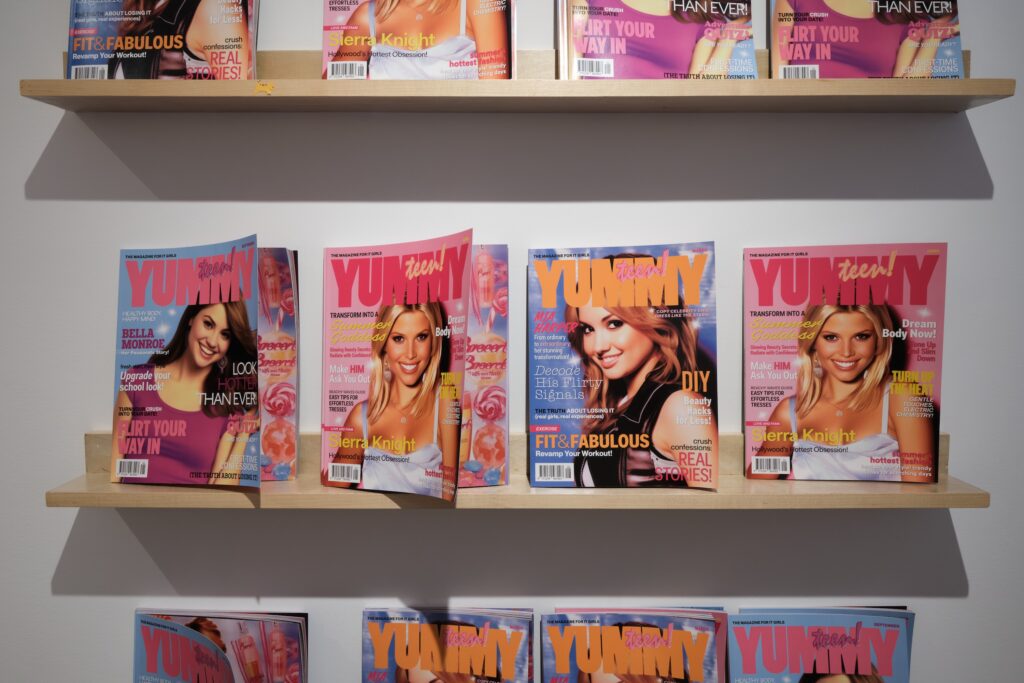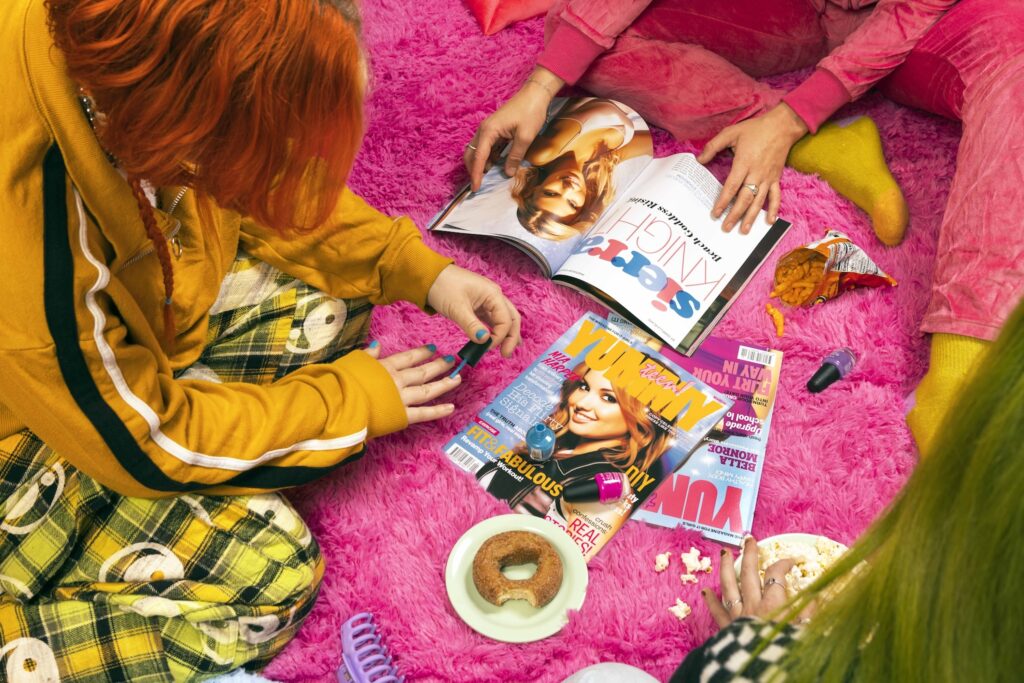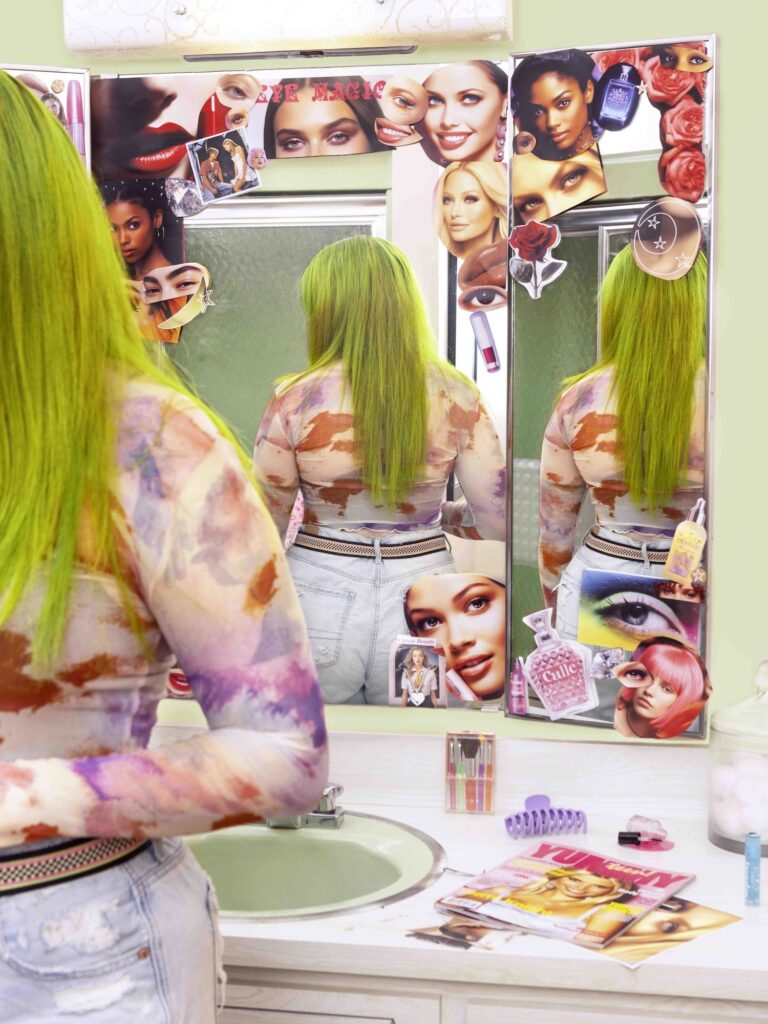Elizabeth Renstrom, Heartthrob, 2023
In Elizabeth Renstrom’s studio, there are shelves filled with pink goodies: a can of Aqua Net, a fluffy leopard blanket, perfume bottles, pencils, faux fur, the pretty princess phone of 1980s teen-movie bedrooms we wanted to live in as young girls. They’re props, it turns out, in both the literal and metaphorical senses of the word: objects Renstrom uses to stage her images, but also visual representations of narratives we’re given of femininity, consumerism, and bodily autonomy.
Over the years, Renstrom, a photographer and photo editor, has produced significant editorial work for the New Yorker, the New York Times, VICE, and TIME, among others. She’s shot portfolios for TIME and the New York Times, made covers for Salty and Numéro Berlin, campaigns for Dice and Vimeo, and photographed for the book Carnal Knowledge: Sex Education You Didn’t Get in School (2020). For both her editorial and personal work, she arranges her props to illustrate richly complex ideas using vibrant color, nostalgia, and humor.
In her recent series Yummy (2023), now on view at Baxter St at the Camera Club of NY, Renstrom combines still-life photography and AI-generated imagery inspired by the world that women of a certain age inherited—a world women are still inheriting, whether they’re teens now or millennials witnessing the aesthetics of our teen years making a comeback; who were raised on magazines like Seventeen, CosmoGirl, and others; who were sold butterfly clips and low-rise jeans by their Claire’s and Wet Seal ad pages; who listened when they told us how to lose the zits and gain a beach body, or how to be fifteen, flirty, and thriving.


Teen magazines from the early 2000s are what initially got Renstrom into photography; she read them growing up in Connecticut. These magazines brimmed with bright, airbrushed, catalog-esque shots of teen models with flowing hair and glossy lips in power poses. Happy, smiling young women leaned with hands on hips, flitted on beaches, washed flawless skin in a bathroom mirror, did crunches for summer in the magazines’ pages, their frosted eyeshadow twinkling as they got into limos for prom.
For Yummy, Renstrom concentrated on this aesthetic, liberally sprinkled with the glory of neon graphics, to remember and comment on their impact. When I visited her studio, she pulled out an issue of the now-defunct magazine YM from October 2002 to show me some of her inspiration for the project. Avril Lavigne is on the hot-pink cover, fake growling in a white button-down shirt, black tie askew. It’s an issue I vividly remember owning.
A child of this era like myself, Renstrom was excited by the possibility of generating her own images using Midjourney, prompting it to reproduce visuals in the style of teen magazines like YM. These appear in three separate branches across the exhibition. The first is a series of three print magazines featuring AI-generated cover stars, advertisements, and editorials. The magazine was designed by art director Elena Foraker, who combed Renstrom’s AI images with editorial sections constructed by the writer Coralie Kraft, also using AI. Stylized with a darkly humorous undercurrent, the publication is called Yummy Teen!—as much a diminutive as a critique of the way young women have often been sexualized within dominant cultural narratives.


The second aspect of the project features actual photographs, which Renstrom staged at a friend’s childhood home in Pennsylvania. She cast teen girls to interact with Yummy Teen! magazines at a fictional sleepover, cut and collaged Yummy Teen! onto their walls, and wove the magazines into these girls’ fictional lives. Nail polish drips onto the carpet, rogue Cheetos find their way out of bags, feathery pens wait to be used. A series of brightly shadowed eyes are cut from a pile of faces on the floor and stuck onto a mirror. “We’re remixing these things, but we’re also being really violent with this image,” Renstrom says, referring to the way women’s faces and bodies have been cut apart to create another idealized image. “It reflects how we feel about ourselves when we’re reading it.”
The third aspect is a physical installation in Baxter St of furry, pink beanbags on top of a bright lavender carpet, in front of a wall painted pink. The installation invites visitors to apply custom stickers and images from Yummy Teen! to the wall, just like the girls in the photographs do. For a few moments, Renstrom wants us all to be teen girls, to understand a life even if we never had the occasion to remember it.
Much about being a teen girl is about longing—having a crush, wishing to lose weight, wanting to fit in with great clothes and beautiful hair. Renstrom captures that by flashing images from the past back to us: the heartthrobs, the perfume ads, the stars we loved and wanted to be. The cover of the June issue of Yummy Teen!, for example, features the AI-generated star Sierra Knight, her blond hair glistening and teeth pearly white, not unlike teens on the Laguna Beach of our youth who were paired with headlines promising to teach us how to “tone up and slim down,” “make HIM ask you out,” and “radiate with confidence!”

Yummy lives in the uncanny valley of 2000s girlhood, where all its images and text are just slightly familiar in ways enlightening and jarring. Teen magazines were so prolific in their time and of such a specific style and tone; that AI images and text may be generated from them in the first place is a comment on their ubiquity and uniformity. They look and feel exactly as they did when they were first published, and with such accuracy that I wonder if I’ve seen them before. And, of course, I have. Yummy is as much about nostalgia as it is satire, as much commentary as memory. There’s a certain absurd hilarity to the phrase “Hot Bod!” independent of any context, and especially as it appears on stickers Renstrom made for the exhibition opening.
Renstrom’s experiences with AI reflected the problems in the images that proliferated mainstream print culture during this time period. Her project features a multitude of ethnicities, for example, but she found she had to ask for that specifically when prompting Midjourney; otherwise, a thin white woman was the norm. “I didn’t have to prompt for it to feed me a woman of a certain size,” Renstrom says. “A white woman is often what will be popped out unless you prompt it to give you a different race. There’s lots of aspects of it that are so fucked up and interesting.”
In bold pinks, yellows, purples, and greens, Renstrom tells the story of what it’s like to be a teen receiving these messages—and then an adult woman dealing with their aftermath. “I think we all indulged in these magazines in a really insecure time of our lives, where we’re looking for guidance and advice,” she says. “This project is a tribute to that, but also a critical eye at the way that these magazines play off those insecurities. It’s a lot about the way we talked to women during this time.”

All photographs courtesy the artist and Baxter St at the Camera Club of NY
Renstrom’s work is always asking audiences to query what they’re seeing. As Coralie Kraft tells me, Renstrom is “trojan horse-ing” commentary into her work about gender, about femininity, about the way we talk, and have talked, about women, the way we have understood or not understood our relationship to consumerism. There were times, Renstrom says, when her work was dismissed for being too nostalgic, frivolous, glossy, feminine. But those who write it off for its aesthetics are missing the point. “I feel really strongly about my palette and the kind of textures and softness that I bring in,” she continues. “I want it to feel inviting, so that you spend time and look at what I’m trying to say or the media I’m trying to put in front of you.”
The return of Y2K aesthetics has coincided with a cultural reconsideration of how we look at stories of the pop icons whose public lives defined the decade, including Janet Jackson, Britney Spears, and Pamela Anderson. Renstrom’s work lives here, too, in its own reconsiderations of “ordinary teenage girls,” as she says. I think of the writer Olivia Gatwood’s poem “When I Say That We Are All Teen Girls”: Even the men who laugh their condescending laughs / when a teen girl faints at the sight of her / favorite pop star, even those men are teen girls, / the way they want so badly to be so big / and important and worshipped by someone.
Renstrom shows us that the state of the teen girl is more universal than we think, that similar experiences color generations of people confronted by comparison, self-doubt, and fear. What we find in her work is that maybe we’re all hoping for a way out, all hoping to be loved, zits and all.
Yummy is on view at Baxter St at the Camera Club of NY through February 2, 2024.



























